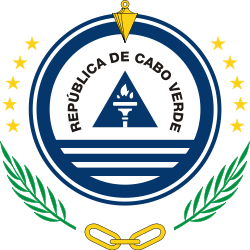Timeline of Maio, Cape Verde
Part of a series on the |
|---|
| History of Cape Verde |
 |
| Colonial history |
| Independence struggle |
|
|
The following is a timeline of the island of Maio, Cape Verde.
Prehistoric era
- 136 to 113 million years ago: The seamount that is now known as Maio started to form[1]
- 20 to 18 million years ago: Burdigalian rocks formed[2]
- 15 to 7 million years ago: Langhian and Messinian rocks formed[3]
- Around 11 million years ago: Tortonian rocks started to form[3]
- 9 to 7 million years ago: Tortonian rocks formed and created the Monte Branco Rock Formation[3]
- During the Ice Age, the island was possibly connected with Maio, though a third of that island was underwater, it formed a part of the "East Island". Its size was approximately 3,000 to 3,500 km2 at the time. It was north-south, it was about 150–200 km long and its width was 20 km and 50 km in the northern part
- Around 6,000 to 5,000 BC: The Eastern Island of Cape Verde broken up into Boavista, Middle and Maio Islands, the Middle Island would later be underwater and became a nearly shallow part of the ocean.
Colonial era
See also: Timeline of Portuguese Cape Verde
- The island was discovered on May 1, 1460 and gave its name to the date that it discovered
- Mid-16th century: The first populated settlement on the island
- 1580 - Population around 50
- 1650 - Population: around 120
- 1750 - Population: around 250
- 1800 - Population: around 700
- mid-18th century: The English merchant ships started trading salt to England from Porto Inglês, slaves mined the salt, the Portuguese shipped it from Calheta do Maio to Portugal
- 1814 - 23 January: The inconclusive Battle of Maio was fought between British and French frigate squadrons off the island's southern coast on 23 January 1814 in the last stages of the Napoleonic Wars, the Portuguese Empire was also at war at the time and allied against France.
- 1832 - Estimate population: 2,500[4]
- 1843 - USS Yorktown was making its way to visit the nearby island of Santiago and some other African places, it visited Maio on September 4, instead, it sunk around the island on September 6 making it one of the first American ships and likely its first sloop to sink in Cape Verdean waters and Maio island. The crew stayed for over a month until October 8 when the USS Dale arrived to pick up the crew and they were transferred to the Portsmouth.
- 1872 - A church opened financed by the salt taxes
- Late 19th century: Maio was strickened by drought and famine
- 1887 - Forte de São José became a lighthouse
- 1900 - Population: 1 900
- 1930 - Population: around 2 000
- 1930s - Economic crisis started mainly after the Great Depression and famines struck the island, the hardest was in 1950 where people emigrated to North America and western Europe
- 1940 - Population: 2 237[5]
- 1950 - Population: 1 924[5]
- 1960 - Population: 2 680[5]
- 1970 - Population: 3 466[5]
- 1974 - April: the Carnation Revolution took place in Portugal, the Estado Novo regime collapsed, Cape Verde became an autonomous province
After independence in 1975-1999
- 1975
- July 5: Cape Verde declared independence from Portugal and became and independent nation
- The island capital Porto Inglês changed its name to Vila do Maio, residents still calls it by the former name today
- 1976 - Onze Unidos football (soccer) club established
- 1977 - Barreirense football (soccer) club established
- 1979 - Académica do Maio football (soccer) club established in Calheta
- 1980 - Population: 4 098[5]
- 1983 - July 6: Académico 83 do Porto Inglês football (soccer) club established
- 1990 - Population: 4 969[5]
- Maio Island League football (soccer) competition established
21st century
- 2000 - Population: 6 754 - the largest 10-year population addition[6]
Aerial view of the southern part of Maio through a plane in 2008
- Around 2009: The eastern island road becomes paved
- 2010
- Population: 8 303[6]
- Taça da Ilha do Maio or Taça Djarmai and the Super-Taça da Ilha do Maio or Super-Taça Djarmai was established
- 2014 - The newer Estàdio Municipal do Maio opened in the eastern part of the city
- 2015 - The Second Division was installed to the Maio Island League
See also
- Timeline of Boa Vista, Cape Verde
- Timeline of Brava, Cape Verde
- Timeline of Fogo, Cape Verde
- Timeline of Sal, Cape Verde
- Timeline of Santiago, Cape Verde
- Timeline of Santo Antão, Cape Verde
- Timeline of São Nicolau, Cape Verde
- Timeline of São Vicente, Cape Verde
References
- ↑ Muller, R. (2008). Age, spreading rates and spreading symmetry of the world’s ocean crust. 9 (Q04006). Geochemistry Geophysics Geosystems. pp. 1525–2027.
- ↑ Stillman, C. J. (1982). The geological history of Maio, Cape Verde Islands. 139. Journal of the Geological Society. pp. 347–361. doi:10.1144/gsjgs.139.3.0347.
- 1 2 3 Mitchell, J. G. (1983). On dating the magmatism of Maio, Cape Verde Islands. Earth and Planetary Science Letters. pp. 61–76.
- ↑ Roberts, Edmund (1837). Embassy to the Eastern Courts of Cochin-China, Siam, and Muscat. New York: Harper & Brothers. p. 17.
- 1 2 3 4 5 6 Source: Statoids
- 1 2 Source: Instituto Nacional de Estatísticas.
This article is issued from Wikipedia - version of the 12/5/2016. The text is available under the Creative Commons Attribution/Share Alike but additional terms may apply for the media files.